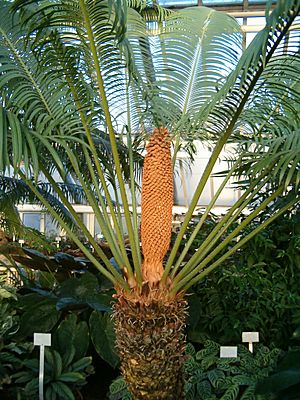Fossil Cycad National Monument facts for kids
The Fossil Cycad National Monument was a special protected area in South Dakota, USA. It started in 1922. This place was famous for having hundreds of fossils of ancient plants called cycads. It was one of the biggest collections of these fossils in the world! Sadly, people stole or broke many of the fossils. Because of this, it stopped being a national monument in 1957. You can find this area in northwestern Fall River County, near the city of Edgemont.
Contents
Discovery of Ancient Plants

The amazing fossil beds were found in 1892 by F. H. Cole. He was from Hot Springs, South Dakota. These fossils were inside rocks that were 120 million years old! These rocks are part of the Dakota Sandstone Formation.
Mr. Cole took pictures of the fossils. He sent them to Professor Henry Newton, who was a geologist at the Smithsonian Institution. Later, in 1893, Professor Thomas MacBride wrote the first description of the site. Everyone thought there were huge amounts of cycad fossils from the Cretaceous period.
Cycads are plants that look a bit like ferns. But they are not related to ferns at all! The ones found here were as big as trees.
In 1920, a scientist named George Reber Wieland got the land. He studied ancient plants, so he was a paleobotanist. He wanted to protect the cycads from being damaged. Two years later, he offered the land back to the government. He wanted it to become a national monument. This way, the fossils would be safe.
Becoming a National Monument
The area officially became a national monument on October 21, 1922. President Warren G. Harding made this happen. The monument covered about 1.3 square kilometers (320 acres). It was located at the southern entrance to the Black Hills of South Dakota.
People said it was "one of the most interesting fossil-plant beds ever found." The fossils were very well preserved. Scientists all over the world knew about this special place.
The person in charge of Wind Cave National Park also looked after this new monument. But local ranchers helped with the daily care.
Why It Was No Longer Protected
Even before it officially became a national monument, many visible fossils were taken. Some were even taken by George Wieland himself. In 1935, more fossils were dug up. These new fossils were also removed by Wieland.
The site was kept as a monument for some years. People hoped that wind and rain would uncover new fossils. But this did not happen. So, on September 1, 1957, the Fossil Cycad National Monument was closed. The land was given to the Bureau of Land Management.
In 1980, workers building a highway found even more fossil cycads. In 1997, the site was named an "Area of Critical Environmental Concern." This means it's a special place that needs careful protection.
Images for kids


